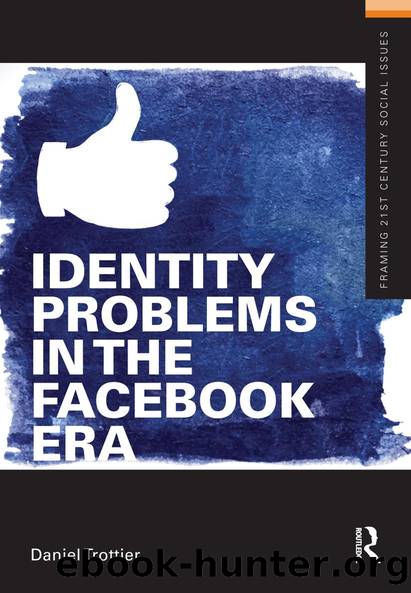Identity Problems in the Facebook Era by Daniel Trottier

Author:Daniel Trottier [Trottier, Daniel]
Language: eng
Format: epub
Tags: Social Science, Sociology, General
ISBN: 9781135089979
Google: jAUVAgAAQBAJ
Publisher: Routledge
Published: 2013-11-12T05:54:44+00:00
Adolescence and High School
Some older digital media users express gratitude that there was no online service like Facebook to document their adolescence (Jurgenson 2012b). For many teenagers, high school is associated with experimentation and self-discovery, including actions they may later regret. In the case of sexting, eight percent of 17-year-olds have sent a sexually suggestive image using their cell phone, and 30 percent have received such content (Lenhart 2009). Those who abstain may be the subject of rumors propagated by their classmates (Ringrose et al. 2012). Falsified stigmas can still cause social harm when peers interpret them as being truthful (cf. Thomas and Thomas 1928). Many young people turn to digital media to maintain their own reputations, but also to either support or damage the reputations of their peers.
Bullying is often framed as a physical ordeal, but it also has a communicative component that can be transferred online (Juvonen and Gross 2008). More than a quarter of adolescents who use mobile phones were harassed on these devices (Lenhart et al. 2010a). In this case, the social media service is the repository for psychological abuse, and mobile phones are the devices that transmit this harm. We may wonder if anonymityâor at least facelessnessâamplifies this kind of harassment. Scholars have observed that mediated communication, in comparison to face-to-face exchanges, âinsulated teens from the consequences of their actionsâ (Shariff 2008: 76). These teenagers may know each other, but they do not have to face one other when they circulate stigmatizing details through digital media.
Bullying may leak from high-school hallways onto digital media. Leaks can also flow in the opposite direction, such as when a studentâs online presence is revealed to his or her peers. In 2009, 14 percent of American teenagers maintained blogs (Lenhart et al. 2010b). These blogs may serve as outlets for personal troubles. However, this otherwise vital act of self-expression can become stigmatizing if discovered by classmates. Users who finished high school before the rise of Facebook may consider themselves lucky for avoiding such risks. However, past stigma may creep back into usersâ lives when peers document this life stage on the Internet. The online service Classmates.com long predates social media, and boasts âover 160,000 digitized high-school yearbooks available for you to view and share photosâ (Classmates 2013). Likewise, former classmates may scan analog photographs from yearbooks, and discuss embarrassing anecdotes on platforms like Facebook.
Download
This site does not store any files on its server. We only index and link to content provided by other sites. Please contact the content providers to delete copyright contents if any and email us, we'll remove relevant links or contents immediately.
Adding Value to Policy Analysis and Advice by Claudia Scott; Karen Baehler(456)
Sociological Perspectives of Health and Illness by Constantinos N. Phellas(445)
Race and American Political Development by unknow(441)
American Government and Politics Today by Steffen W. Schmidt Mack C. Shelley Barbara A. Bardes(429)
Human and Global Security : An Exploration of Terms by Peter Stoett(425)
Control Of Oil - Hardback by Kayal(409)
Entrepreneurship Education and Training: The Issue of Effectiveness by Colette Henry Frances Hill Claire Leitch(368)
The Catholic Church and European State Formation, AD 1000-1500 by Jørgen Møller(356)
Materializing the Middle Passage by Jane Webster;(352)
The World According to China by Elizabeth C. Economy(344)
Left Is Not Woke by Susan Neiman(328)
Turkey's Relations with the West and the Turkic Republics: The Rise and Fall of the Turkish Model by Idris Bal(314)
Theories of Counseling and Psychotherapy: A Case Approach by Nancy L. Murdock(313)
Cross-Cultural Child Development for Social Workers by Lena Robinson(309)
Japan's Ainu Minority in Tokyo by Mark K. Watson(297)
Advances in Child Development and Behavior, Volume 37 by Patricia J. Bauer(296)
Laboratory Life by Bruno Latour(294)
Beyond Service: State Workers, Public Policy, and the Prospects for Democratic Administration by Greg McElligott(285)
The Oxford Handbook of Museum Archaeology by Stevenson Alice;(275)
